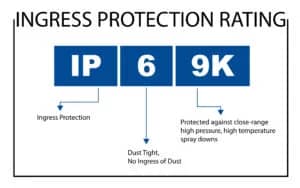IP stands for Ingress Protection. The IP rating system classifies the degree of protection provided by an enclosure against intrusion from foreign bodies like dust and moisture. The IP-rating is defined in international standard EN 60529 (British BS EN 60529:1992, European IEC 60509:1989). It consists of the letters “IP” followed by two digits, where each digit has a specific meaning[1][2].
Table of Contents
Here is a breakdown of the IP rating system:
- The first digit indicates the level of protection against solid objects, ranging from 0 (no protection) to 6 (dust-tight).
- The second digit defines the protection level against moisture, varying from 0 (no protection) to 9 (high-pressure hot water from different angles).
For example:
- IP65 Means: Protected against dust and low-pressure jets of water.
- IP67 Means: Protected from total dust ingress and can be immersed between 15 centimeters and 1 meter in depth.
- IP68 Means: Offers total dust ingress protection and can withstand long-term immersion under a specified pressure.
- IP69 Means: Provides total dust ingress protection and can endure steam-jet cleaning.
Understanding the IP’s rating system of a device is crucial in determining its resistance to environmental factors like dust and water, ensuring that it meets specific durability requirements for various applications.
Citations:
[1] https://www.enclosurecompany.com/ip-ratings-explained.php
[2] https://rainfordsolutions.com/resources/faqs/ip-ratings-and-standards-explained/
[3] https://www.jabra.com/blog/waterproof-or-water-resistant-whats-behind-an-ip-rating/
[4] https://www.dsmt.com/resources/ip-rating-chart/
[5] https://www.iec.ch/ip-ratings


2 thoughts on “What is ip rating?”